View in other NatureServe Network Field Guides
NatureServe
Montana
Utah
Wyoming
Idaho
Wisconsin
British Columbia
South Carolina
Yukon
California
New York
Juniper Haircap Moss - Polytrichum juniperinum
General Description
Plant: Acrocarpous (Vitt 1988). Small to robust, erect moss growing in loose tufts or extensive patches. Gray-green to blue-green, but becoming red-brown with age. Stems (1-)4-5(-10) cm tall, simple, and with brown tomentum only at the base.
Leaf: When dry, leaves imbricate, mostly erect, and almost straight. When moist, erect spreading to widely spreading. Lanceolate to linear-lanceolate leaf (3-8 mm long) from a sheathing base. Leaf is slender and shiny with infolded margins. Sheath is oblong-rectangular, yellowish, and tapers to the leaf. Costa is excurrent as a red awn, somewhat toothed, and is made of lamellae.
Leaf Cells: Teeth consist of 3 cells (1 large cell above & 1-2 small cells below). Sheath: Cells are narrowly rectangular, 4-6:1. X-S: Marginal laminae are of 1 layer and 5-7 cells long, transparent, and overlap to cover some of the lamellae; in X-S cells are smooth or slightly crenulate. In top view marginal laminae are elongate with thick walls. Lamellae X-S: 20+, each 6-8 cells high, with the uppermost cell ovate to pyriform, thick-walled, ending with a distinct knob, and smooth (or rarely faintly papillose). The uppermost cell of each lamella that occurs under the overlapping lamina is ovoid and less strongly thickened.
Diagnostic Characteristics
P. juniperinum usually grows in drier habitats than P. strictum. The former also has stems covered with dense brown rhizoids near its base whereas P. strictum has a white wooly stem (FNA 2007).
P. juniperinum has reddish awns rather than entirely hyaline awns as in the similar P. piliferum. The former is also larger and grows in somewhat moister habitats (FNA 2007).
Range Comments
Widely distributed and very common. Greenland; Canada: AB, BC, MB, NB, NL, NT, NS, NU, ON, PE, QC, YT; USA: AL, AK, AZ, AR, CA, CO, CT, DE, GA, ID, IL, IN, IA, KS, KY, ME, MD, MA, MI, MN, MO, MT, NE, NV, NH, NJ, NM, NY, NC, OH, OK, OR, PA, RI, SC, SD, TN, UT, VT, VA, WA, WV, WI, WY; Mexico; West Indies; Central America; s South America; Europe; n, c Asia; Atlantic Islands (Macaronesia); Pacific Islands (New Zealand); Australia; Antarctica (FNA 2007). In Montana, known from Carbon, Carter, Cascade, Deer Lodge, Flathead, Gallatin, Glacier, Granite, Lake, Lincoln, Madison, Mineral, Missoula, Park, Powell, Ravalli, Sanders, Stillwater, and Sweet Grass Counties (Elliott 2016).
Observations in Montana Natural Heritage Program Database
Number of Observations: 553
(Click on the following maps and charts to see full sized version)
Map Help and Descriptions
Relative Density
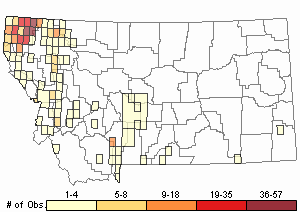
Recency
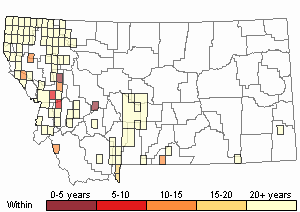
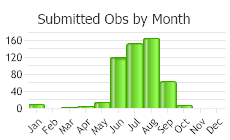
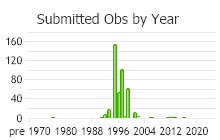
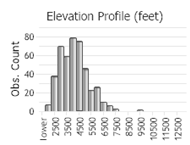 (Observations spanning multiple months or years are excluded from time charts)
(Observations spanning multiple months or years are excluded from time charts)
Habitat
Exposed, well-drained soils, usually acid soils. In old fields, openings in forest, along trails and roadcuts, on thin soil over rock, and on open ridges. Rarely in moist or wet places. Low to high elevations.
Reproductive Characteristics
Dioicous. Male plants with an abrupt transition to a spicate fertile portion.
Seta is 1-5 mm tall, stout, yellow to red-brown. Capsule is 2.5-5 mm long, longer than wide (1.5-2:1), dark-brown to red-brown, glaucous when fresh, becoming horizontal at maturity. Several sporophytes to a plant, but one seta to a perichaetium. Calyptra covers the capsule, is of densely interwoven hairs or felt, and white to light brown.
Stewardship Responsibility
References
- Literature Cited AboveLegend:
 View Online Publication
View Online Publication Elliott, J.C. and A.K. Pipp. 2018. A Checklist of Montana Mosses (1880-2018). Updated 3 January, 2020. Montana Natural Heritage Program, Helena, Montana. 73 pp.
Elliott, J.C. and A.K. Pipp. 2018. A Checklist of Montana Mosses (1880-2018). Updated 3 January, 2020. Montana Natural Heritage Program, Helena, Montana. 73 pp. Flora of North America Editorial Committee, eds. 2007. Flora of North America North of Mexico. Volume 27. Bryophytes: Mosses, Part 1. Oxford University Press, Inc., NY. xxi + 713 pp.
Flora of North America Editorial Committee, eds. 2007. Flora of North America North of Mexico. Volume 27. Bryophytes: Mosses, Part 1. Oxford University Press, Inc., NY. xxi + 713 pp. Vitt, D. J. Marsh, and R. Bovey. 1988. Mosses, Lichens & Ferns of Northwest North America. Seattle, WA: University of Washington Press. 296 p.
Vitt, D. J. Marsh, and R. Bovey. 1988. Mosses, Lichens & Ferns of Northwest North America. Seattle, WA: University of Washington Press. 296 p.
- Additional ReferencesLegend:
 View Online Publication
View Online Publication
Do you know of a citation we're missing? Aho, Ken Andrew. 2006. Alpine and Cliff Ecosystems in the North-Central Rocky Mountains. Ph.D. Dissertation. Bozeman, Montana: Montana State University. 343 p.
Aho, Ken Andrew. 2006. Alpine and Cliff Ecosystems in the North-Central Rocky Mountains. Ph.D. Dissertation. Bozeman, Montana: Montana State University. 343 p. Elliot, J. C. 1993. Second checklist of Montana mosses. Unpublished report. U.S. Forest Service, Region 1. Missoula, MT. 45 pp.
Elliot, J. C. 1993. Second checklist of Montana mosses. Unpublished report. U.S. Forest Service, Region 1. Missoula, MT. 45 pp. Grove, A.J. 1998. Effects of Douglas fir establishment in southwestern Montana mountain big sagebrush communities. M. Sc.Thesis. Bozeman, MT: Montana State University. 150 p.
Grove, A.J. 1998. Effects of Douglas fir establishment in southwestern Montana mountain big sagebrush communities. M. Sc.Thesis. Bozeman, MT: Montana State University. 150 p. Lawton, E. 1971. Keys for the Identification of the Mosses on the Pacific Northwest. Reprinted from 'Moss Flora of the Pacific Northwest'. Published as Supplement No. 2 of the Journal of the Hattori Botanical Laboratory. Nichinan, Miyazaki, Japan. 66 pp.
Lawton, E. 1971. Keys for the Identification of the Mosses on the Pacific Northwest. Reprinted from 'Moss Flora of the Pacific Northwest'. Published as Supplement No. 2 of the Journal of the Hattori Botanical Laboratory. Nichinan, Miyazaki, Japan. 66 pp. Lawton, E. 1971. Moss Flora of the Pacific Northwest. Hattori Botanical Laboratory. Japan: Yamabuki-cho, Shinjuku-ku, Tokyo. 362 pages plus appendices.
Lawton, E. 1971. Moss Flora of the Pacific Northwest. Hattori Botanical Laboratory. Japan: Yamabuki-cho, Shinjuku-ku, Tokyo. 362 pages plus appendices.
- Web Search Engines for Articles on "Juniper Haircap Moss"





